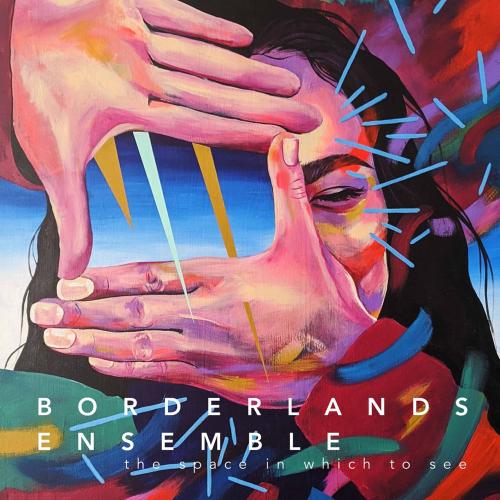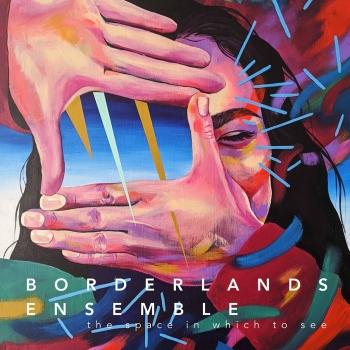
The Space in Which To See Borderlands Ensemble
Album info
Album-Release:
2021
HRA-Release:
06.08.2021
Label: New Focus Recordings
Genre: Classical
Subgenre: Classical Crossover
Artist: Borderlands Ensemble
Album including Album cover Booklet (PDF)
- Anne Leilehua Lanzilotti (b. 1983): The Space in Which To See:
- 1 Lanzilotti: The Space in Which To See: I. This Is How You See Me the Space in Which To Place Me 01:11
- 2 Lanzilotti: The Space in Which To See: II. To See This Space See How You Place Me in You 03:02
- 3 Lanzilotti: The Space in Which To See: III. This Is How To Place You in the Space in Which To See 01:33
- 4 Lanzilotti: The Space in Which To See: IV. The Space in Me You See Is This Place 02:48
- Jay Vosk (b. 1948):
- 5 Vosk: Passing Ships 11:23
- Vivian Fine (1913 - 2000): Songs and Arias:
- 6 Fine: Songs and Arias: No. 1, Love-Song 02:09
- 7 Fine: Songs and Arias: No. 2, Elizabethan Song 01:45
- 8 Fine: Songs and Arias: No. 3, Rupert's Aria From the Opera “Unfulfilled” 01:48
- 9 Fine: Songs and Arias: No. 4, Arioso 02:35
- 10 Fine: Songs and Arias: No. 5, Duet 01:52
- 11 Fine: Songs and Arias: No. 6, Aria From the Cantata “Leben O süsses schreckliches Leben” 01:13
- 12 Fine: Songs and Arias: No. 7, Canto hondo 02:55
- Charles Daniels (1878 - 1943):
- 13 Daniels: Dream Machine 10:16
- Alejandro Vera:
- 14 Vera: Ometéotl 14:55
- Anonymous:
- 15 La Llorona (Arr. B. Tyers & J. Lundy for Chamber Ensemble) 04:00
- Alfredo Gil (1915 - 1999) & José de Jesús Navarro (1913 - 1993):
- 16 Gil, Navarro: Sin un amor (Arr. J. Lundy for Chamber Ensemble) 03:35
- Juventino Rosas (1868 - 1894):
- 17 Rosas: Sobre las olas (Arr. J. Lundy for Chamber Ensemble) 04:18
Info for The Space in Which To See
Hailing from the American Southwest, the Borderlands Ensemble was formed in 2017 to reach across social boundaries and bring communities together through concert music. the space in which to see, their debut release, was catalyzed by a project entitled “Place and Identity in the Borderlands” which specifically explored connections between the shared cultural identity of Arizona and Mexico. Led by artistic director Johanna Lundy, three collaborators brought their specialized knowledge to the project: Dr. José Luis Puerta, guitarist; Dr. Luis E. Coronado Guel, Mexican historian; and Jessica Gonzales, visual artist who created paintings inspired by the music that are included in the album artwork. The collection of music on this release speaks both to the group’s commitment to building cultural bridges through chamber music as well as its refined and impactful performances.
The album opens with a work written for Borderlands by Anne Leilehua Lanzilotti. the space in which to see sets a text by Layli Long Soldier, a citizen of the Oglala Lakota Nation. The poem engages with issues of Indigenous identity and place, concepts which are obviously at the fore in the borderlands region. The opening movement features an unsettling, percolating ensemble texture around which clarion horn notes sound a call to attention. In the second, a quote from the heroic climax of Stravinsky’s Firebird Suite is heard in augmentation in the horn over insistent violin notes and a skittering, rhythmic gesture in the cello. The third setting is static and ominous, with unstable sonorities in the strings creating a shrouded texture. The last movement also evokes Stravinsky, albeit his austere later style heard in works such as Requiem Canticles. Individual instrumental entrances form an ambiguous chorale before Lundy’s horn closes the work with a series of meditative breaths.
Jay Vosk’s Passing Ships for horn and string quartet is an abstract representation of human migration. The horn and quartet occupy opposite roles in a dialogue, and Vosk establishes a mournful tone throughout that captures the struggle against obstacles that migrants face in their pursuit of freedom and security.
Vivian Fine’s Songs and Arias contrasts richly expressive movements with moments that gently poke fun at the classical tradition. Fine ventures through allusions to several styles and eras in the work, from the rhapsodic, Romantic quality of the outer movements, “Love Song” and “Canto Hondo (Deep Song)”, to the early music inspired “Elizabethan Song” and “Arioso”, to the Debussy inspired “Duet.” The work’s more humorous moments come in two excerpts from fictional compositions: “Rupert’s Aria from the opera ‘Unfulfilled’” with its raucous horn part and a concertino style aria from a non-existent cantata, “Life, Oh Sweet Terrible Life.”
Mexico City born Charles Daniels’ Dream Machine explores the illogical and fantastical landscape of dreams. The composition avoids recognizable main themes, instead linking together evocative, colorful textures tied together by a logic all their own.
Alejandro Vera’s Ometéotl is inspired by the Aztec god of creation, representing the creative essence that powered all other gods and deities. Integrating pre-Hispanic rhythms and imitations of ancient instruments, Vera conjures a world where faith was invested in powerful forces beyond human control. Angular lines and imitative passagework evoke a ritualistic, mystical expression.
The final three tracks on the album are arrangements of Mexican music by artistic director and hornist Johanna Lundy. “La Llorona”, or the “wailing woman,” is an important figure in Mexican folklore, the embodiment of tragic melancholy. “Sin un Amor” is a representative song from the repertoire of the famed New York City based bolero group Los Panchos, formed in 1944. The final arrangement, “Sobre las Olas” is probably the best known of the three, originally composed by Juventino Rosas. Despite his Indigenous heritage, Rosas composed in a wide range of styles, from European waltzes to polkas to mazurkas.
Borderlands Ensemble:
Ellen Chamberlain, violin
Joseph Rousos-Hammond, violin
Freya Creech, violin
Ann Weaver, viola
Sarah Toy, viola
Robert Chamberlain, cello
Johanna Lundy, horn
José Luis Puerta, guitar
The Borderlands Ensemble
was formed in 2017 by Johanna Lundy, Ellen Chamberlain, Sarah Toy, Ann Weaver, and Robert Chamberlain. After many years working together in an orchestral setting, they were ready to explore new concert formats and grow relationships with audiences. The ensemble’s performances aim to disrupt barriers imposed by classical music venues and traditions, making classical music more engaging and relevant to all people. Past concerts have taken place at breweries, biker bars, and coffee houses and the group has collaborated with the Museum of Contemporary Art-Tucson, the Consulate of Mexico in Tucson, the Downtown Chamber Series (Phoenix), El Crisol Mezcal Bar, Galeria Mitotera, the Loft Cinema, and many others.
The Borderlands Ensemble supports composers and their creation of new music and believes in the medium of contemporary art music to shed light on humanity and create collective experiences. They also enjoy performing pop, rock, and folk crossover music. They strive to celebrate and promote diversity in everything they do, with the long-term goal to change the public’s perception of classical and contemporary art music and to create measurable social change in the borderlands community through music.
The project that inspired this album, Place and Identity in the Borderlands, was an exploration into the shared cultural identity of Arizona and Mexico, presented through the lens of classical chamber music. Special collaborators joined the group: guitarist Dr. José Luis Puerta, Mexican historian Dr. Luis Coronado Guel, and visual artist Jessica Gonzales. Drs. Puerta and Guel were instrumental in selecting popular and folk repertoire to compliment the new compositions. Gonzales created four original paintings that were inspired by the new works on this album – her artwork is featured throughout.
Special thanks to the Arts Foundation for Tucson and Southern Arizona, The University of Arizona Fred Fox School of Music, and the Tucson Guitar Society for their support of this project. Additionally, this project would not have been possible without the support of private donors and collaborators.
Booklet for The Space in Which To See












